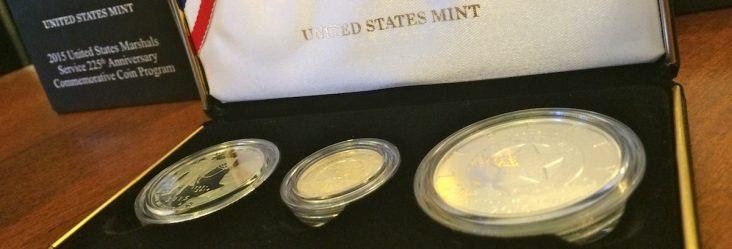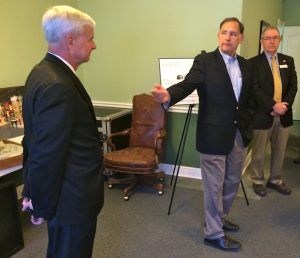$3.05 million from coin sales presented to Marshals Museum by Sen. Boozman, Rep. Womack
by May 7, 2016 1:15 pm 389 views

U.S. Marshals Service 225th Anniversary Commemorative Coins
U.S. Sen. John Boozman, R-Ark, and U.S. Rep. Steve Womack, R-Rogers, were in Fort Smith Saturday (May 7) to present the United States Marshals Museum with a $3.053 million check earned from surcharges on the U.S. Marshals Service 225th Anniversary Commemorative Coin.
The presentation took place at the U.S. Marshals Museum Office on North 3rd Street with Boozman and Womack addressing a small gathering.
Boozman first introduced the United States Marshals Service 225th Anniversary Commemorative Coin Act while still a member of the U.S. House of Representatives during the 111th Congress (Jan. 3, 2009 to Jan. 3, 2011). During that time, Boozman opted to run for a U.S. Senate seat against former Sen. Blanche Lincoln, D-Ark.
At that point Boozman handed off the bill to Womack, who began collecting signatures from the 290 co-sponsors needed to get the bill placed on the House’s calendar. Womack ended up with 301 signatures while Boozman, after defeating Lincoln in the 2010 midterm election, continued working on the bill in the Senate. It was signed into law on April 2, 2012, with the first $5 million in proceeds committed to the funding of the national museum.
In January 2007, the U.S. Marshals Service selected Fort Smith as the site for the estimated 50,000-square-foot national museum. The museum is to be built on 15.9 acres along the Arkansas River that is being donated by the Robbie Westphal family.
Fundraising efforts will continue for the $55 million project with architect discussions underway and a planned opening sometime in 2018.
NO POLITICS
On Saturday, Jim Dunn, president and CEO of the U.S. Marshals Museum, credited both men as well as their Democratic counterparts for not letting “politics” affect the bill’s passage. Dunn said that in spite of Boozman’s decision to run against Lincoln, the two “continued to work with each other, and not once, not a single solitary time, was there a hint of any politics concerned with this bill.”

“Each of the two and their staff told us they would do whatever they could do even if it meant the other getting credit for it because they knew this meant jobs for Arkansas, economic growth for Fort Smith, and, most importantly, that it honored the U.S. Marshals Service,” Dunn said.
After the Boozman-Lincoln race, Dunn continued, Womack took up the cause and enlisted the aid of then-Democratic House member Mike Ross, “and those two worked shoulder to shoulder to make this happen.”
“That’s what is great about Arkansas. Our elected representatives will do what’s best for us regardless of the politics,” Dunn said.
A DISTANT TASK
In comments to kick off the event, Boozman reminisced about the fight to get the U.S. Marshals Museum located in Fort Smith, where during the 19th Century, the U.S. Marshals Service was the only law enforcement agency with the jurisdiction to enter Indian Territory and frontier lands over which the U.S. District Court for the Western District of Arkansas presided.
Deputy U.S. Marshals headquartered in Fort Smith patrolled a 74,000-square mile territory.
In 2005, the U.S. Marshals Service began its search to find a city to host a commemorative museum. Fort Smith and Staunton, Va., were the two finalists out of 16.
“I look around the room, and it seems like yesterday that we learned the Marshals Museum was up for grabs,” Boozman said. “The idea of us actually acquiring it then seemed a distant task and like something that would be very, very difficult to do, but it’s amazing how things fell into line.”
Boozman credited Dunn and Womack and the people of Fort Smith for embracing the idea and said they did “a tremendous job like nobody else does compared to this region,” joking that neither he and Womack “ever want to see this type of a bill again.”
“The outcome was great, but the problem is you’ve got to get so many people on board. You can imagine the sum of these that would come about if they weren’t hard to do, and they are difficult to do,” he said. “You have to get your colleagues and you have to go and beg people to sign these things, but Steve did a great job in the House, and we worked hard in the Senate, and it was really the entire delegation that came together that enabled us to get this done. It’s been a great joy to be a part of it.”
Womack called getting the “suspension bill” that would become H.R.886 passed a “race against time.”
“There are only two of these that go down a year,” Womack said, noting that the U.S. Marshals Coin was in the mix with the Cooperstown Baseball Coin and a third attached to the U.S. Marine Corps.
He continued: “One-by-one, you sit down with members and say, ‘Hey I need you to co-sponsor this bill, it doesn’t cost taxpayers anything, and here’s what it does.’ And it’s a five-minute elevator speech, and you’ve got to do it 290 times, so it takes a while. So we got to work on it in the 112th Congress in the spring.”
Womack, who also serves on the West Point Board of Visitors, said one of his proudest moments in Congress was visiting the West Point Mint where the U.S. Marshals Coins were pressed and holding the front and back images of the gold coins in his hands.
“I can’t tell you the feeling that I got when I took those and gazed down at them,” he said. “It all came full circle, all the work we did with our colleagues – the circulation of the bill, the passage of the bill, the amendment to the bill, the next vote on the bill, and then the signing into public law. It was a source of great pride for me and I will always remember this effort as something that helped my district, helped our city here in Fort Smith, and at the same time brought great credit to an organization like the U.S. Marshals Service.”
STILL AVAILABLE
The coins were produced from Jan. 1 to Dec. 31 of 2015 after which production ceased. However, according to U.S. Marshals Museum Vice President-Development Alice Alt, the museum partnered with Walmart to sell a few remaining coins at their stores. Silver coins are available from the Zero Street-Fort Smith and Greenwood Walmart locations for $51.95.
Initially, they were produced in three variations with an introductory price of $412.60 for the gold, $46.95 for the silver, and $14.95 for the clad-half dollar. Not intended for general circulation, they were produced in limited quantities with the United States Mint authorizing a maximum of 100,000 $5 gold coins, 500,000 silver dollar coins and 750,000 clad half-dollars.
Alt said golds and clads would likely be confined to eBay, but said the Museum is keeping an inventory that will go on sale when the facility opens and there will be approximately $50,000 worth of coins available “while supplies last.” That figure will be predominately comprised of the silver and clads, but there will be “a few gold coins” in the mix.
